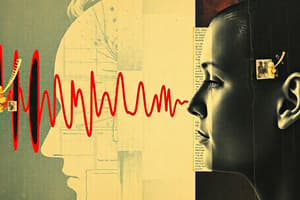Podcast
Questions and Answers
What is Audition?
What is Audition?
The sense of hearing.
What does Frequency refer to in the context of sound?
What does Frequency refer to in the context of sound?
The number of complete wavelengths that pass a point in a given time.
What is Pitch?
What is Pitch?
A tone's highness or lowness.
What are Decibels?
What are Decibels?
What is the Middle Ear?
What is the Middle Ear?
What is the Inner Ear?
What is the Inner Ear?
What is the Cochlea?
What is the Cochlea?
What does Place Theory explain?
What does Place Theory explain?
What does Frequency Theory explain?
What does Frequency Theory explain?
What is Conduction Hearing Loss?
What is Conduction Hearing Loss?
What is Sensorineural Hearing Loss?
What is Sensorineural Hearing Loss?
What do older people tend to experience regarding Hearing Loss?
What do older people tend to experience regarding Hearing Loss?
What are the four distinct skin senses?
What are the four distinct skin senses?
What is Gate Control Theory?
What is Gate Control Theory?
Flashcards are hidden until you start studying
Study Notes
Audition
- Audition refers to the sense of hearing, fundamental for perceiving sound.
Frequency
- Frequency indicates the number of complete sound wave cycles passing a point in a specific time frame.
Pitch
- Pitch describes a tone's perceived highness or lowness, directly linked to frequency.
- Long sound waves produce low frequencies and low pitches, while short sound waves result in high frequencies and high pitches.
Decibels
- Decibels serve as the measuring unit for sound energy, quantifying the intensity of sound.
Middle Ear
- The middle ear is the chamber situated between the eardrum and cochlea, containing three tiny bones: hammer, anvil, and stirrup.
- These bones concentrate eardrum vibrations onto the cochlea's oval window.
Inner Ear
- The inner ear is the deepest section of the ear, housing the cochlea, semicircular canals, and vestibular sacs, pivotal for processing sound and balance.
Cochlea
- The cochlea is a coiled, bony, and fluid-filled tube within the inner ear that transforms sound waves into nerve impulses.
Place Theory
- Place theory elucidates how humans perceive high pitches by associating the pitch heard with specific stimulation locations on the cochlea's membrane.
Frequency Theory
- Frequency theory explains the perception of low pitches, where the rate of nerve impulses in the auditory nerve corresponds to the tone's frequency, enabling pitch detection.
Conduction Hearing Loss
- Conduction hearing loss arises from damage to the auditory system that transmits sound to the cochlea, such as a punctured eardrum.
Sensorineural Hearing Loss
- Sensorineural hearing loss, more prevalent than conductive loss, results from damage to the cochlea's receptor cells or the auditory nerve, also known as nerve deafness.
Hearing Loss
- Older individuals typically maintain higher sensitivity to low frequencies but experience greater loss in high frequencies.
Skin Senses
- The four distinct skin senses include pressure, warmth, cold, and pain, essential for sensory perception.
Gate Control Theory
- Proposed by Melzack and Wall, the gate control theory suggests that the spinal cord contains "gates" that regulate the perception of pain, either blocking it or allowing it to be sensed.
Studying That Suits You
Use AI to generate personalized quizzes and flashcards to suit your learning preferences.



